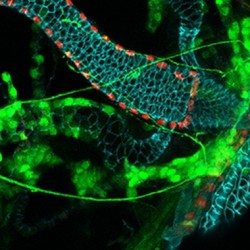By Helen Figueira
January 16, 2014
Time to read: 4 minutes
 Conversations between nutrients, neurons and vessels
Conversations between nutrients, neurons and vessels
Almost 500 years ago, the Italian anatomist Vesalius noted that nerves and blood vessels in mammals grow very closely together. Yet the functional implications of this observation have yet to be fully realised. We know that body tissues require a blood supply to nurture them. Even when unhealthy changes occur such as tumours or excessive fatty tissue, new blood vessels form helping to nurture them. The process, known to scientists as adaptive angiogenesis, has long been assumed to be a response to the changing metabolic needs of the tissues. For obvious reasons, we have come to think of our circulatory system as playing a purely responsive role.
New research from the CSC now questions whether newly formed vessels themselves could play a more active role, and whether the nervous system might help to guide the development of new vessels. Research published today in Cell by Irene Miguel-Aliaga’s team (Gut Signalling and Metabolism Group) shows how small dietary changes in the fly Drosophila melanogaster directly modify its tracheal system – a system of oxygen-delivering interconnected tubes – via the central nervous system. “The fly equivalent of vasculature doesn’t only listen to the target tissue,” affirms Irene, “it listens to the nervous system.” The signal flow, at least in flies, goes from nutrients to nervous system to vasculature.
Irene’s team identified molecules that cause changes in the branching of fly trachea. These insulin-like and VIP (vasoactive intestinal peptide)-like peptides are released from the neurons and are conserved across species. “We have them too,” she confirms. Coupled with the observation that the fly nervous system directs adaptive angiogenesis, Irene’s team were surprised to find evidence that the vasculature itself has an instructive role. “It’s much more active than we previously thought”, she comments. “The implication is that we could target either the neurons or their vascular targets genetically, pharmacologically or otherwise to regulate how these organs are storing nutrients.” Put in more simple terms, if you get fat on account of a specific diet because of the vasculature, the way around this might involve ‘tweaking’ the circulatory system.
The study on flies also uncovered changes in vessels forming around the gut itself. Intriguingly, such changes seem to protect against malnutrition in later life.
“We don’t know yet what the relevance of these findings are to humans,” Irene cautions. First of all, the mechanism identified would have to be conserved in mammals. And setting up experiments to test this is not straightforward. “You’d have to identify the neurons in mammals first,” she explains. “Then you’d need to know which subsets of the vasculature were metabolically relevant.” The major challenge in the more complex rodent model system would be to unpick cause and effect. “We’ve found it in flies because we can turn genes on and off in small groups of neurons and/or oxygen-delivering cells.”
Despite these challenges, Irene hints at the possibility for follow up in humans. “It would be good to find out whether at the anatomical level there is correlative evidence of gut vasculature changing in response to poor or imbalanced diets, or for example following gastric-bypass operations. If we find evidence for such changes,” adds Irene, “we could then try to establish whether these are causative or not.” Additionally, should the nervous system play any directorial role, then Vesalius’s finding would take on a new significance.
BM
Reference: Linneweber, G. A., Jacobson, J., Busch, K. E. E., Hudry, B., Christov, C. P., Dormann, D., Yuan, M., Otani, T., Knust, E., de Bono, M., Miguel-Aliaga, I., 2014. Neuronal control of metabolism through Nutrient-Dependent modulation of tracheal branching. Cell, 156 (1-2), 69-83.
This work was funded by the Medical Research Council, Wellcome Trust, EMBO, an ERC Starting Grant, and a BBSRC project grant.
The Medical Research Council has been at the forefront of scientific discovery to improve human health. Founded in 1913 to tackle tuberculosis, the MRC now invests taxpayers’ money in some of the best medical research in the world across every area of health. Twenty-nine MRC-funded researchers have won Nobel prizes in a wide range of disciplines, and MRC scientists have been behind such diverse discoveries as vitamins, the structure of DNA and the link between smoking and cancer, as well as achievements such as pioneering the use of randomised controlled trials, the invention of MRI scanning, and the development of a group of antibodies used in the making of some of the most successful drugs ever developed. Today, MRC-funded scientists tackle some of the greatest health problems facing humanity in the 21st century, from the rising tide of chronic diseases associated with ageing to the threats posed by rapidly mutating micro-organisms.